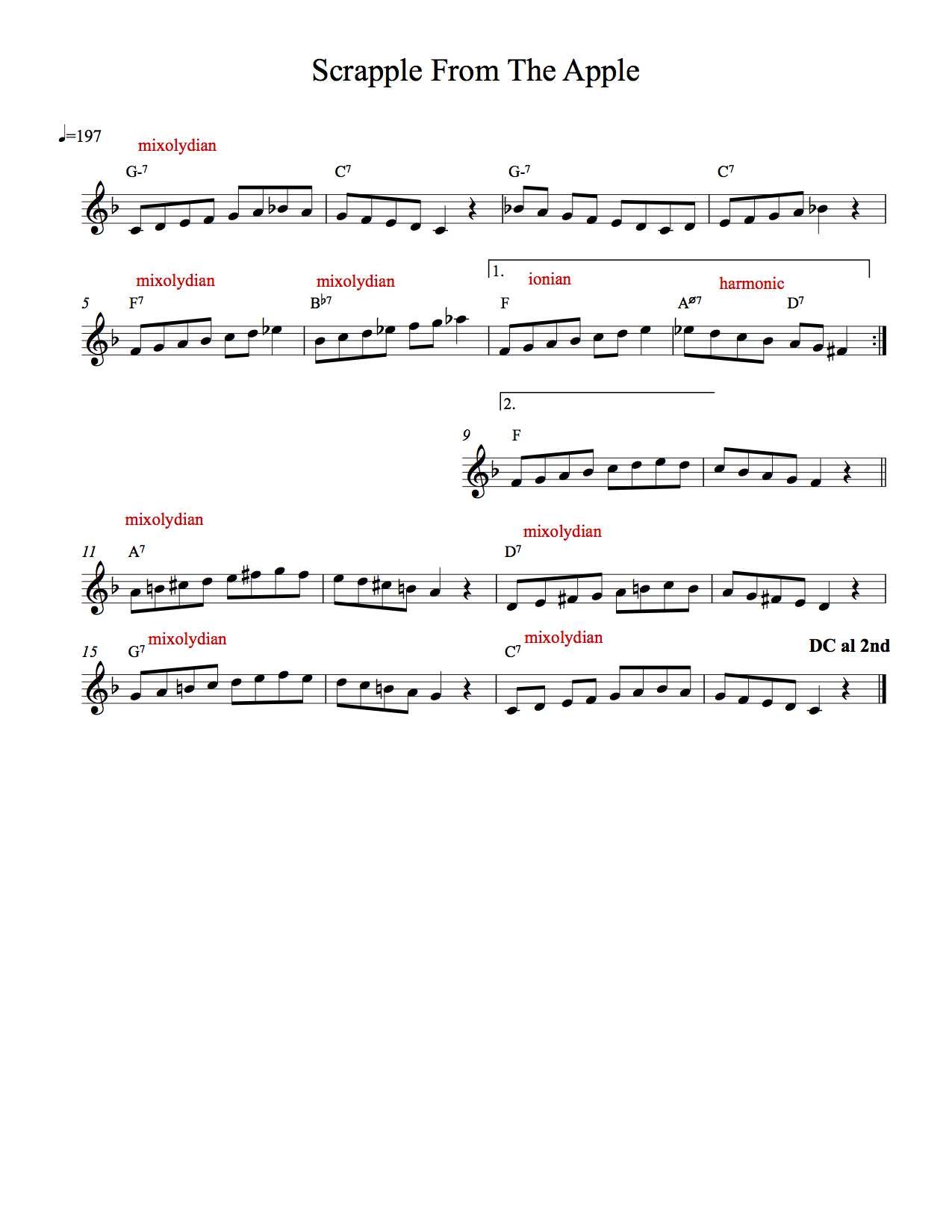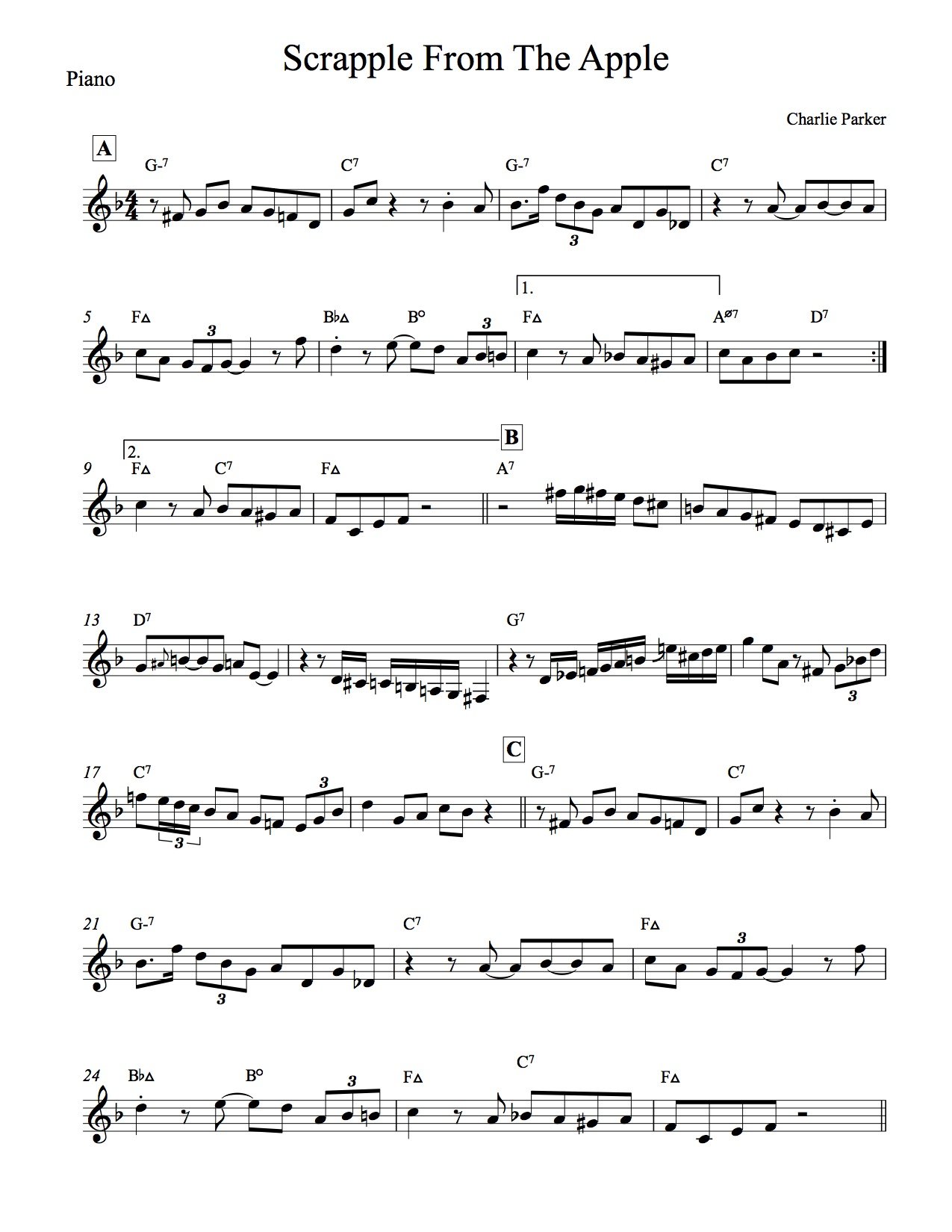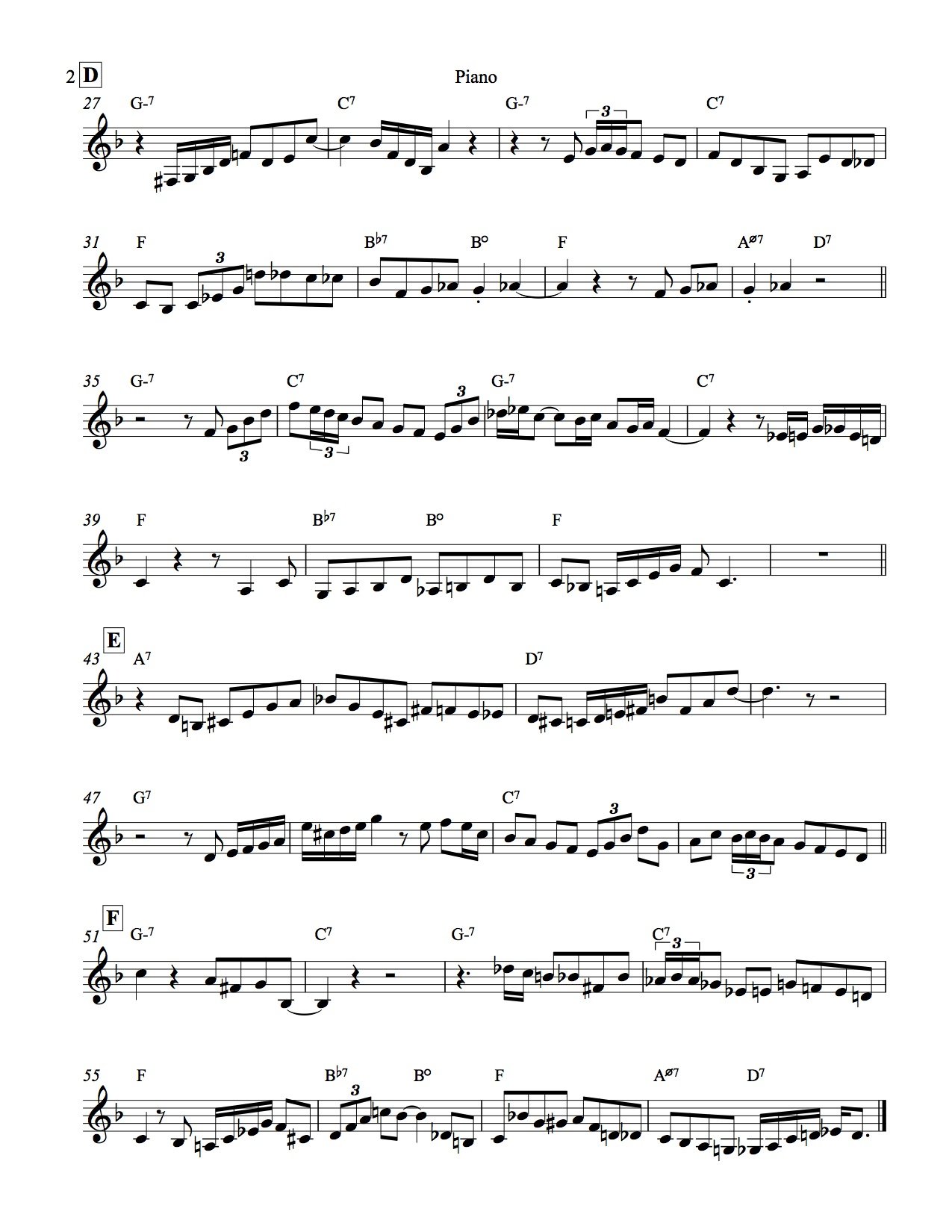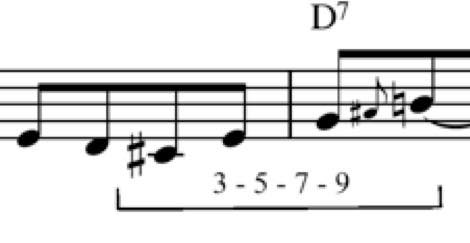Musings on "Scrapple From The Apple"
Students ask so much better questions than we “experienced artists” could ever think of; the ones that are especially simple, obvious, and the most important are usually the ones that we never fully consider until our answer might have the ability to help someone else. For this and many other reasons the act of teaching is vital for personal development. Sometimes in our arrogance we subconsciously assume that we already know the answer so we don’t bother even asking or investigating that question in the first place. (I’m reminded of a quote from Kaufman's excellent "Wired To Create" that describes exceptionally creative people as those that come up with the better questions, the better problems, rather than the better answers and solutions.) This week totally kicked my ass last with a question regarding the tune “Scrapple From The Apple.”“How do I work on improvising over this?”Of course this question was asked everybody was running out the door, including me, so I had about 30 seconds to try to answer. I think whatever I said was long-winded, rushed, and probably not very inspiring, hence the reason for this do-over in the form of a blog. It won’t be 30 seconds, and will definitely be long winded, but hopefully this will be a good start and as direct as it needs to be.1) Check out the recordings! They are amazing!There are some versions of this tune I really love, and it’s those in the groove they contain the foundation of why we do this. I love the version Charlie Parker recorded back in the 1940s, as well as recordings by Dexter Morgan, Blue Mitchell, the Keith Jarrett Trio, and Tom Harrell among many others. I think if you were practicing from the perspective of, “what are they doing? How are they getting this sound?” You’ll always be inspired and motivated to continue deepening your room and chops on a tune like this. If you are practicing from a more intellectual place, out of a pressure or duty to put something together perhaps for a performance, you just won’t be able to joy and excitement is easily felt on these recordings. I know it is an obtuse thing to say, but try to find the vibe and play from that always. By the way, a little research reveals that it was based on an old standard written by Fats Waller called “Honeysuckle Rose.”2) Know your melody and scales, COLD!If the basic building blocks of this song, i.e. the melody and scales inside of it, are not so together that you can play them easily without much effort, then anything else you try to do is going to be almost impossible. (Improvisation is either easy or impossible right?) Issues that come up usually involve us making the tune harder than it needs to be. We do this by isolating small parts, trying too play too fast, or attempting to play things in time when we are still struggling to find notes, fingerings, and basic phrases. Work through the melody, slow and so that you can feel the phrases, home tomorrow, beautiful harmony contained within the line, and all the instrumental and physical techniques and sensations you need to play it out of time. That starts to feel effortless then putting it into tempo can be the easiest thing in the world. That is unless you are still working to get it out of your horn. Always practice from a place were you definitely feel challenged, but you also feel immense satisfaction because you are playing at least 80% of the music without much effort. Then, practice becomes an endless joy rather than a grim duty.Take the same approach basic skills involved in the song. In this case there are a few Mixolydian scales, a major scale, and the often-overlooked harmonic minor scale. This is where, if you have practiced your major scales on a regular basis, we reap the payoff. 3) Work through somebody else's improvisation as an etude.There are a million books and teachers in the world that can spend countless hours giving us important knowledge about scales, theory, harmony, the history of bebop, rhythm, technical information on the most detailed level, and ideas for practice for a dozen lifetimes. You can obtain a great majority of this knowledge intuitively if we use a master solo as an exercise. I’ve included the Charlie Parker solo below as an example. Obviously, in this case the tempo on the recording might be too fast for many of us to play initially, but that’s ok. Playing through even a few phrases very slowly Will allow all of the advanced rhythmic and harmonic elements experience directly first, rather than explained. Adding the theoretical stuff to the sound is easy; working from the other direction is much more difficult and often leads to a unique brand of jazz mental illness where musicians ignore their intuitive knowledge of the music and try to shoe horn it in to an theoretical idea that flattens the music and belies what they actually hear.
3) Work through somebody else's improvisation as an etude.There are a million books and teachers in the world that can spend countless hours giving us important knowledge about scales, theory, harmony, the history of bebop, rhythm, technical information on the most detailed level, and ideas for practice for a dozen lifetimes. You can obtain a great majority of this knowledge intuitively if we use a master solo as an exercise. I’ve included the Charlie Parker solo below as an example. Obviously, in this case the tempo on the recording might be too fast for many of us to play initially, but that’s ok. Playing through even a few phrases very slowly Will allow all of the advanced rhythmic and harmonic elements experience directly first, rather than explained. Adding the theoretical stuff to the sound is easy; working from the other direction is much more difficult and often leads to a unique brand of jazz mental illness where musicians ignore their intuitive knowledge of the music and try to shoe horn it in to an theoretical idea that flattens the music and belies what they actually hear.
 4) Blow!Use small sections of the tune and improvise, using small parts of what you have learned from the above. What sounded good? What made you stop and ask, “What is THAT?” This is where you discover, and adapt preexisting melodies and lines to your own musicality. This is the fun zone :)I love Bird’s solo, because it makes so much musical sense, yet is complex and makes me dig in my ears and head for why it is so logical to the ear, if not always to the brain. Take his solo on the bridge in m. 11-13 as an example:
4) Blow!Use small sections of the tune and improvise, using small parts of what you have learned from the above. What sounded good? What made you stop and ask, “What is THAT?” This is where you discover, and adapt preexisting melodies and lines to your own musicality. This is the fun zone :)I love Bird’s solo, because it makes so much musical sense, yet is complex and makes me dig in my ears and head for why it is so logical to the ear, if not always to the brain. Take his solo on the bridge in m. 11-13 as an example: Why does this sound so good to me? Breaking it down into some parts we can see hear that the first part of the phrase uses a really slick turn centering around the F#-G-F#-E, then descends the scale. While he is using notes from the A Mixolydian scale, when we listen closely we and hear what notes fall on the beat, we discover the sound is closer to E Dorian (E-7), the “important minor” that is tucked inside our dominant/Mixolydian sound:
Why does this sound so good to me? Breaking it down into some parts we can see hear that the first part of the phrase uses a really slick turn centering around the F#-G-F#-E, then descends the scale. While he is using notes from the A Mixolydian scale, when we listen closely we and hear what notes fall on the beat, we discover the sound is closer to E Dorian (E-7), the “important minor” that is tucked inside our dominant/Mixolydian sound: Much like all of the G-7 sounds contained in the first 4 bars of the melody, this “scale inside the scale” is the jumping off point for the beginning of the line. It certainly sounds different than starting on the root of the chord! He then connects this line to the 3-5-7-9 arpeggio of the A7 chord, really outlining the sound of the chord clearly, but also spilling over the bar line into the next measure. Bar lines are like rules: made to be broken!
Much like all of the G-7 sounds contained in the first 4 bars of the melody, this “scale inside the scale” is the jumping off point for the beginning of the line. It certainly sounds different than starting on the root of the chord! He then connects this line to the 3-5-7-9 arpeggio of the A7 chord, really outlining the sound of the chord clearly, but also spilling over the bar line into the next measure. Bar lines are like rules: made to be broken! Here are just a few of the many “movements” through this tune: playing off the "important minor" (5th of the Mixolydian), connecting the 3-5-7-9 arpeggio, and being able to play within and over the bar line. That should be more than enough to practice in one month let alone a week or a day! Of course if the notes of the parent A Mixolydian scale are sketchy, lack certainty or confidence, or have some technical issues yet to be worked out, then the above is totally impossible. If you own them however, then it is completely easy and fun to play and work this stuff up because it sounds really good and you can't stop playing it.5) Play time!Once you have gotten some phrases under your belt, it’s time to groove and really feel why all of this harmonic stuff is amazing; It's connected to the beat! For example: put on a drum machine, a recording of the tune, a metronome clicking on beats two and four, a loop, or an app such as the amazing “Drum Genius” and play your improvisation in time, really feeling the pulse and where your notes fall, whether the upbeat or the downbeat, inside or over the bar line. Feel the rhythm’s that you are creating as they relate to this external reference.6) It’s not about you.Listen to your place in the tune, how you relate to the musicians, and make the solo not about you but all about them. Make the people or sounds you are playing with sound good; now and always. People listen to music more often not just to learn something about the musicians who are playing, but rather to discover and feel something new about themselves. This isn’t about you, which I know sounds strange if you are the one who steps up to a solo mic to take a solo, but tap into the experience of it feeling so good when you play to make the people around you sound good rather than worrying about what people think about “your” playing.Way too many words, but hope this helps. Practice and let me know what you come up with!
Here are just a few of the many “movements” through this tune: playing off the "important minor" (5th of the Mixolydian), connecting the 3-5-7-9 arpeggio, and being able to play within and over the bar line. That should be more than enough to practice in one month let alone a week or a day! Of course if the notes of the parent A Mixolydian scale are sketchy, lack certainty or confidence, or have some technical issues yet to be worked out, then the above is totally impossible. If you own them however, then it is completely easy and fun to play and work this stuff up because it sounds really good and you can't stop playing it.5) Play time!Once you have gotten some phrases under your belt, it’s time to groove and really feel why all of this harmonic stuff is amazing; It's connected to the beat! For example: put on a drum machine, a recording of the tune, a metronome clicking on beats two and four, a loop, or an app such as the amazing “Drum Genius” and play your improvisation in time, really feeling the pulse and where your notes fall, whether the upbeat or the downbeat, inside or over the bar line. Feel the rhythm’s that you are creating as they relate to this external reference.6) It’s not about you.Listen to your place in the tune, how you relate to the musicians, and make the solo not about you but all about them. Make the people or sounds you are playing with sound good; now and always. People listen to music more often not just to learn something about the musicians who are playing, but rather to discover and feel something new about themselves. This isn’t about you, which I know sounds strange if you are the one who steps up to a solo mic to take a solo, but tap into the experience of it feeling so good when you play to make the people around you sound good rather than worrying about what people think about “your” playing.Way too many words, but hope this helps. Practice and let me know what you come up with!

